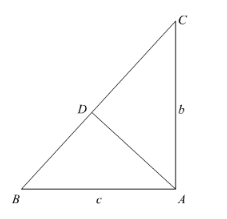Using Pythagoras theorem determine the length of AD in terms of b and c shown in the given figure.

In $\triangle A B C$ and $\triangle D B A$,
$\angle A=\angle D \quad\left(90^{\circ}\right.$ each $)$
$\angle B=\angle B \quad$ (Common)
Therefore, by AA-criterion for similarity, we have $\triangle A B C \sim \triangle D B A$.
$\therefore \frac{A B}{B D}=\frac{B C}{B A}=\frac{A C}{A D}$
Now we will substitute the values of AC and AB
$\therefore \frac{c}{B D}=\frac{B C}{c}=\frac{b}{A D}$
We are finding the value of AD therefore; we will use the following ratios,
$\frac{B C}{c}=\frac{b}{A D}$
Now we will multiple both sides of the equation by $\frac{1}{b}$.
$\frac{B C}{c} \times \frac{1}{b}=\frac{b}{A D} \times \frac{1}{b}$
We will simplify the above equation as below,
$A D=\frac{b c}{B C}$...(1)
But we know that $B C=\sqrt{b^{2}+c^{2}}$ substituting the value of $\mathrm{BC}$ in equation (1) we get,
$A D=\frac{b c}{\sqrt{b^{2}+c^{2}}}$

Click here to get exam-ready with eSaral
For making your preparation journey smoother of JEE, NEET and Class 8 to 10, grab our app now.
